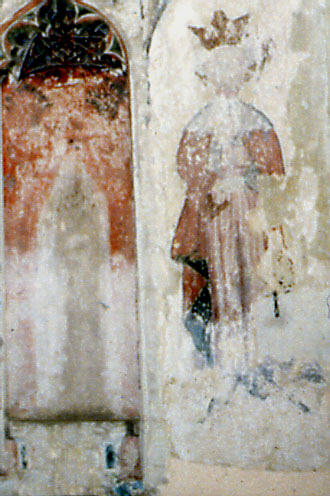Boxford, Suffolk (†St Edmundsbury & Ipswich) Late C.14/Early C.15
St Edmund, King and Martyr

St Edmund, king of the East Angles from before 865, is painted on the right, standing frontally beneath the remains of a painted canopy. Beside him on the left is a recess (there is another above it), with some faded unidentifiable painting in it. Edmund is crowned and wears royal robes (in red, lined with blue) and what was probably an ermine cape over his shoulders. It is very hard to see here, but he holds (in his hands clasped in front of him) the arrow of his martyrdom, his attribute. Whether or not he was actually shot through with arrows by the invading Danes for refusing to deny the Christian faith, there are several paintings of him being martyred in this way in the English parish church and some of them are now on this site.
However he died, Edmund did so at Hellesdon in Norfolk and he was always enormously popular among the East Angles as their martyred king. The town of Bury St Edmund’s was of course his original burial place, but his body suffered many vicissitudes after his death. Hoxne in Suffolk has always claimed to be the true place of his martyrdom and where his body lay for over 30 years before being taken to Bury – certainly there was a St Edmund’s chapel there in the later Middle Ages. His body was also moved to London for three years after a Danish landing at Ipswich in 1010 and then removed to Bury again. And there was a cult of Edmund at Toulouse in France, whence the French claimed to have taken, and ever after kept, his remains after the battle of Lincoln in 1217.
Whatever the truth, together with St Edward the Confessor, Edmund was joint patron of England, presenting King Richard II to the Virgin in the famous Wilton Diptych (National Gallery, London) and his huge popularity remained even after Agincourt in 1415 when St George gained primacy over him as patron saint of England.